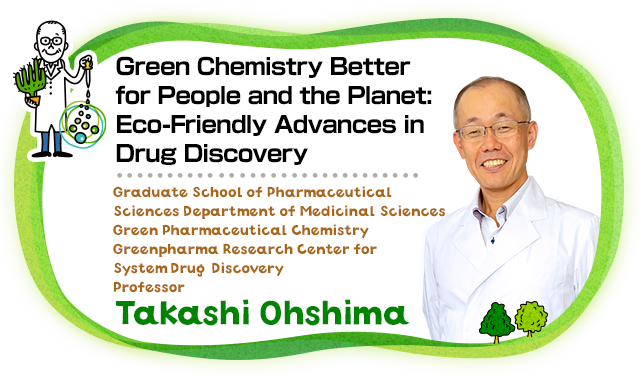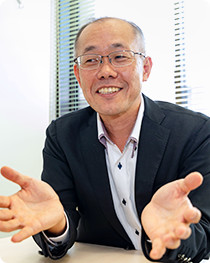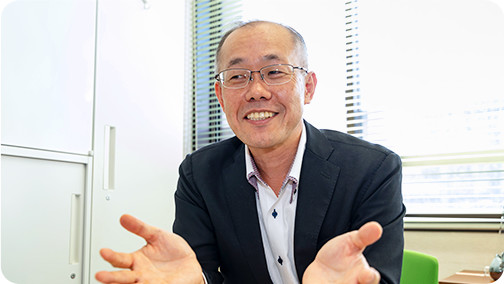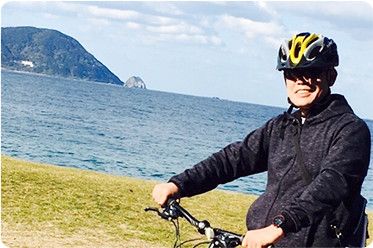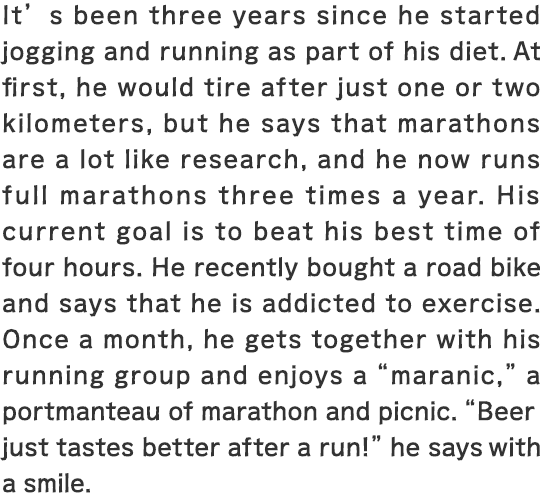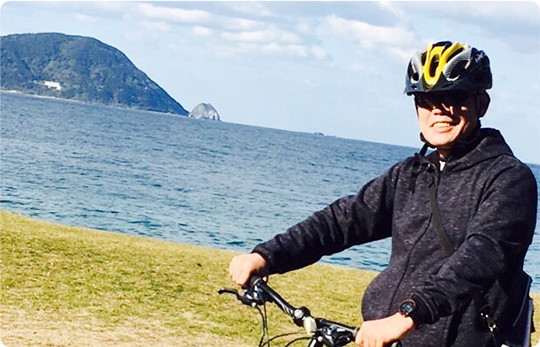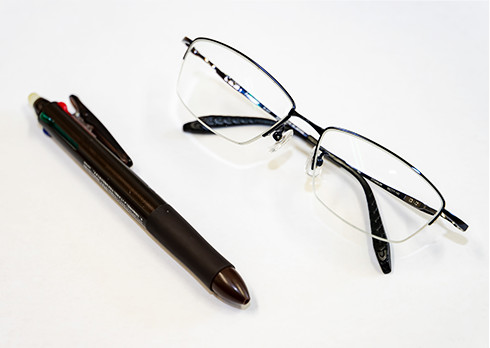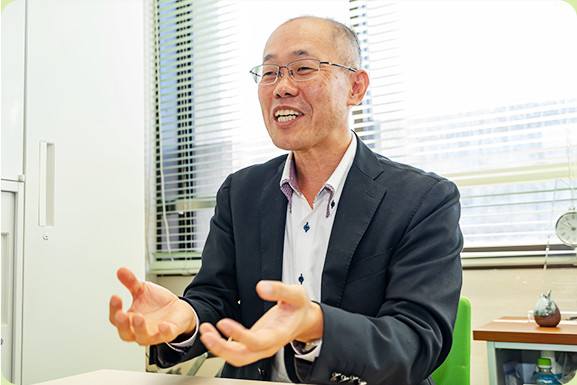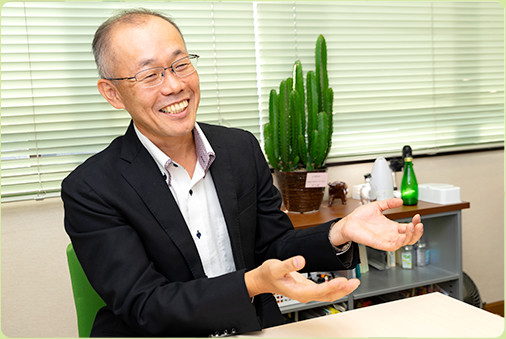 Professor Ohshima has a radiant personality and speaks with a graceful lilt—with lots of accompanying hand gestures. Looking over at a cactus on his office bookshelf—a present he says he received from his research students—he explains his research group’s monthly birthday and dinner parties that allow him and his students to get to know each other. Professor Ohshima is all smiles as he describes how much he loves chatting with his research students.
Professor Ohshima has a radiant personality and speaks with a graceful lilt—with lots of accompanying hand gestures. Looking over at a cactus on his office bookshelf—a present he says he received from his research students—he explains his research group’s monthly birthday and dinner parties that allow him and his students to get to know each other. Professor Ohshima is all smiles as he describes how much he loves chatting with his research students.
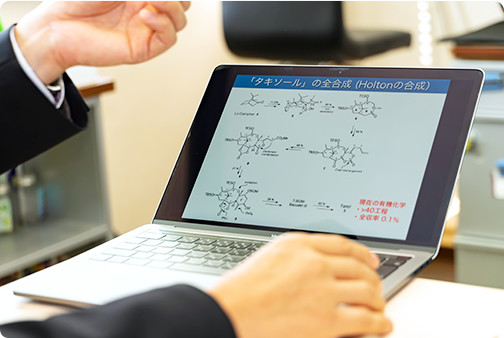 Professor Ohshima shares one of his presentations. He’s a forward-thinking professor, always looking to connect with other researchers around the world. Even during our interview, he shows us his lecture materials and takes time to explain his research.
Professor Ohshima shares one of his presentations. He’s a forward-thinking professor, always looking to connect with other researchers around the world. Even during our interview, he shows us his lecture materials and takes time to explain his research.
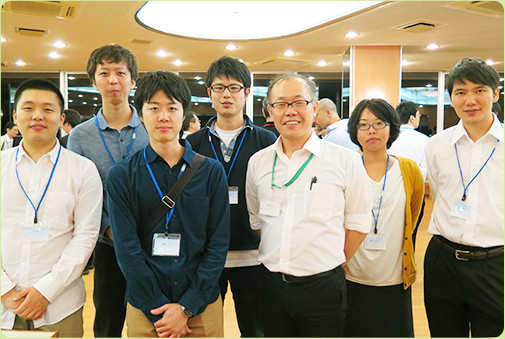 Professors Ohsima and students participated in the symposium.
Professors Ohsima and students participated in the symposium.
 Professor Ohshima has a radiant personality and speaks with a graceful lilt—with lots of accompanying hand gestures. Looking over at a cactus on his office bookshelf—a present he says he received from his research students—he explains his research group’s monthly birthday and dinner parties that allow him and his students to get to know each other. Professor Ohshima is all smiles as he describes how much he loves chatting with his research students.
Professor Ohshima has a radiant personality and speaks with a graceful lilt—with lots of accompanying hand gestures. Looking over at a cactus on his office bookshelf—a present he says he received from his research students—he explains his research group’s monthly birthday and dinner parties that allow him and his students to get to know each other. Professor Ohshima is all smiles as he describes how much he loves chatting with his research students.
My research looks at green pharma—how to make the medicines we depend on "benign by design". Usually drugs can take more than ten years to go from development to market, and synthesizing pharmaceutical products can generate a good deal of waste. To measure just how much, we use the E-factor metric, which refers to the ratio of the mass of waste per mass of product and gives us a barometer to gauge the impact that certain industries have on the environment. The process of pharmaceutical industry has an E-factor of 25–100, which is extremely high, especially when compared with industries such as oil refining, which has an E-factor of just 0.1. What we need is to develop green chemistry synthesis technology that is safe for both humans and the environment.
 Professor Ohshima shares one of his presentations. He’s a forward-thinking professor, always looking to connect with other researchers around the world. Even during our interview, he shows us his lecture materials and takes time to explain his research..
Professor Ohshima shares one of his presentations. He’s a forward-thinking professor, always looking to connect with other researchers around the world. Even during our interview, he shows us his lecture materials and takes time to explain his research..
Let me give you an example. In the 1970s, a medication called paclitaxel was created, which was said to be a dream drug for cancer treatment. The drug was made from the bark of the Pacific yew tree. But problems with commercialization soon surfaced due to the fact that the bark from one tree could only produce enough paclitaxel to treat a single person, so researchers sought total synthesis of the drug, which attempts to completely synthesize natural products from the smallest possible precursors. Through the ceaseless efforts of countless researchers, total synthesis was eventually achieved in the 1990s, but it remained difficult to maintain the drug in steady supply. That is because the process involved a large number of chemical reactions that produced an equally large amount of waste, which drove costs through the roof. But we can be sure that in the near future organic chemistry will be able to produce such complex compounds without negatively impacting the environment.
 Professors Ohsima and students participated in the symposium.
Professors Ohsima and students participated in the symposium.
High-grade catalysts are required for green chemistry reactions, and as we combine different catalysts the possibilities continue to expand. I’m current working to develop environmentally friendly catalytic reactions as well as the efficient synthesis of various medical and bioactive natural products. In order to discover excellent catalysts for these reactions, we’ve conducted research and experiments into metal complex catalysis in organic and organometallic synthesis, and we have been successful in developing a catalyst that can be repeatedly used in the synthesis of ester compounds that are commonly used in medicines and perfumes. We have also succeeded in synthesizing antiviral drugs that can be recycled after use. The most common method to produce such synthesis reactions is batch production, where all the raw materials are put into a reaction tank and the product is extracted once the reactions are complete. At Kyushu University, however, we envision the application and commercialization of high value-added bioactive compounds and are conducting research on the synthesis of structurally complex compounds using continuous flow synthesis, in which reactions are performed using a variety of raw materials that are continuously passed through a pipe or tube.
We are currently engaged in joint research with industry to expand green chemistry. At the Kyushu University Greenpharma Research Center for System Drug Discovery, we are also working on new research that fuses green chemistry and drug discovery chemistry, aiming to create drugs that are both human-friendly and environmentally sound.


What do you think of when you hear the word chemistry? Positive impressions may conjure up images of any number of things like food, perfume, cosmetics, pharmaceuticals, or new inventions like erasable pens or heat-generating clothing. But pollution might be the first thing you think of if you have a negative impression of the field. In chemistry textbooks, all you need to do is to synthesize your product, and it's simply assumed that many of these chemical reactions will produce waste. But now we live in a time of fierce environmental conservation, which has given rise to types of pseudo-green chemistry. So that begs the question: what should our research really be focusing on?
I remain steadfast in my dedication to authentic green chemistry. I plan to refine my objectives and propose hypotheses for experiment design that envisages new materials and new chemical reactions. It’s such a wonderful feeling when you are able to achieve the desired result. But then again, you’ll sometimes find a quite unlikely combination to be highly reactive, and it is in those unexpected moments that research becomes truly exciting.
I am of the opinion that organic chemistry is modern-day alchemy. While we may not be able to turn iron into gold, there exist infinite element combinations that can yield results of far greater value. In fact, Kyushu University’s own Professor Morita, of the Faculty of Sciences, achieved the stunning feat of discovering a brand-new element now known as nihonium after repeatedly attempting reactions using mind-boggling combinations. This is one of many examples that shows that chemistry can be more creativity than discovery. The field is brimming with innovation and new things are being created all the time, and that is why I find chemistry so captivating.

![]()




